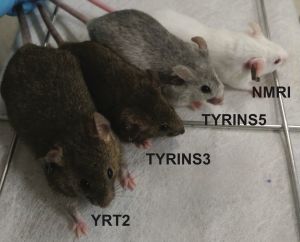 Ratones transgénicos utilizados en este trabajo de investigación
Lluís Montoliu, CNB-CSIC
Ratones transgénicos utilizados en este trabajo de investigación
Lluís Montoliu, CNB-CSIC
- Un nuevo trabajo de investigación del CNB-CSIC y el CIBERER determina los límites del gen de la tirosinasa de ratón, que le permiten desarrollar su patrón de expresión.
- El trabajo es fruto de la comparación de modelos modificados genéticamente de ratón generados gracias a los avances en técnicas de edición genética como el CRISPR.
El contenido genómico de cada una de nuestras células es idéntico, y sin embargo, las diferentes células del cuerpo presentan morfologías variadas y desarrollan funciones tan distintas como la contracción muscular o la visión. Esto se debe a los diferentes patrones de expresión de los genes en cada tipo celular, una característica fundamental durante el desarrollo de un organismo. Aunque el ADN sea el mismo, existen “interruptores” (los elementos reguladores del genoma no codificante) que definen la organización genómica y tiene una gran influencia en los niveles de expresión de los genes.
Uno de los genes más utilizados como modelo para entender los procesos de “encendido” o “apagado” de un gen es el de la tirosinasa, qué produce la enzima responsable de la biosíntesis de la melanina. Las mutaciones en este gen son las más comunes en el albinismo, una condición genética poco frecuente que produce deficiencias en la visión y que además puede afectar a la pigmentación de la piel, pelo y ojos. Sin embargo, debido a que su deficiencia no tiene otros efectos perjudiciales en el organismo, se ha utilizado desde los años 90 como modelo de estudio de genes de mamíferos en ratones para la realización de experimentos de transgénesis e ingeniería genética que van desde la microinyección de ADN al desarrollo de la técnica CRISPR.
Ahora, un artículo publicado en la revista Scientific Reports por investigadores del Consejo Superior de Investigaciones Científicas y el Centro de Investigación Biomédica en Red de Enfermedades Raras (CIBERER) revela la estructura genómica completa del gen de la Tirosinasa (Tyr) y describe sus límites, a derecha e izquierda, en el genoma, que permiten mantener la expresión correcta del gen en los dos tipos celulares de ratón donde se expresa este gen: los melanocitos y el epitelio pigmentado de la retina.
Lluís Montoliu, investigador del Centro Nacional de Biotecnología (CNB-CSIC) y del Centro de Investigación Biomédica en Red de Enfermedades Raras (CIBERER) y responsable del proyecto destaca que este trabajo es fruto de avances realizados a lo largo de casi 30 años, e incorpora estudios novedosos y sofisticados de cromatina (3C) y de edición genética (CRISPR). “En la actualidad conocemos el dominio de expresión completo del gen de la tirosinasa, prácticamente todos sus elementos reguladores y los límites del gen”. Gracias a la utilización de técnicas de biología molecular, CRISPR y transgénesis se ha podido comparar y entender la función del locus de la tirosinasa en líneas de ratones generados a lo largo de 30 años de trabajo. “Así hemos podido identificar la formación de diferentes estructuras en la cromatina que son las responsables finales de garantizar la expresión correcta del gen”. Las mutaciones introducidas en estos elementos reguladores producen la pérdida de las fronteras que definen el gen y se asocian a anomalías en la expresión del mismo o en los genes vecinos, lo cual puede tener consecuencias patológicas. De ahí la importancia de conocer los límites de los genes.
Los elementos frontera que delimitan y regulan el funcionamiento del gen de la tirosinasa de ratón se han analizado también en un modelo de peces cebra, gracias a la colaboración con el grupo de José Luis Gómez Skarmeta del Centro Andaluz de Biología del Desarrollo (CABD, centro mixto del CSIC, Universidad Pablo de Olavide y la Junta de Andalucía), recientemente fallecido.
Referencia
Boundary sequences flanking the mouse tyrosinase locus ensures a faithful pattern of gene expression. D Seruggia, A Fernández, M Cantero, A Fernández-Miñán, JL Gómez-Skarmeta, P Pelczar, L Montoliu. Sci Reports 2020, 23rd September
DOI: https://doi.org/10.1038/s41598-020-72543-0






